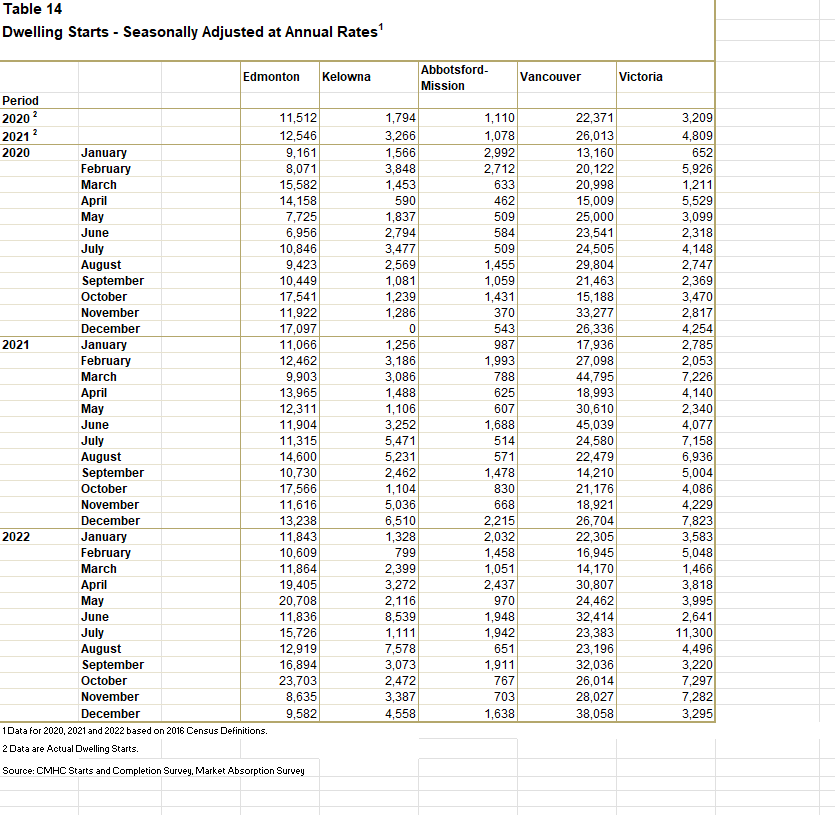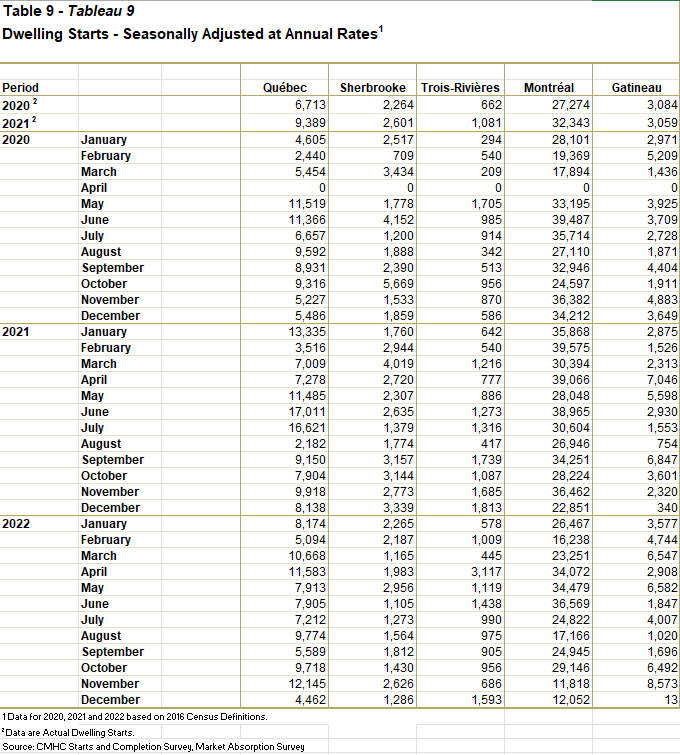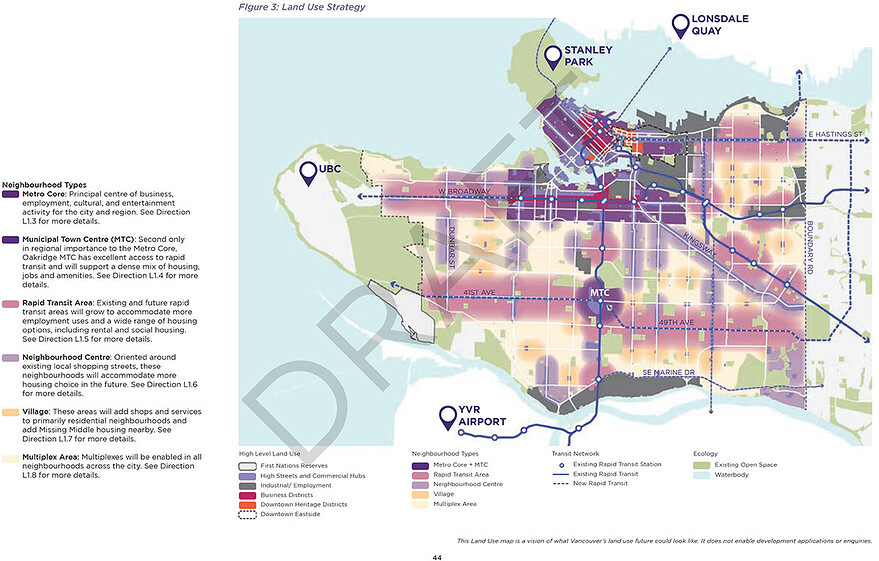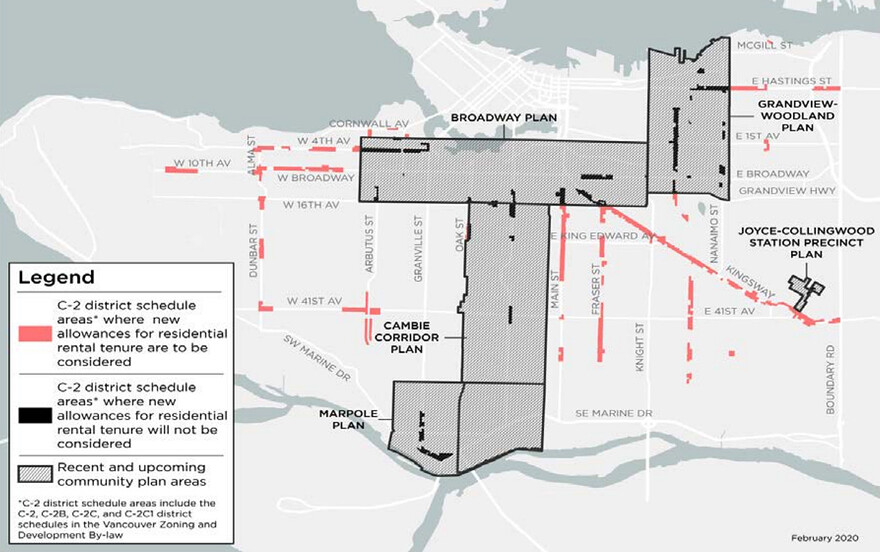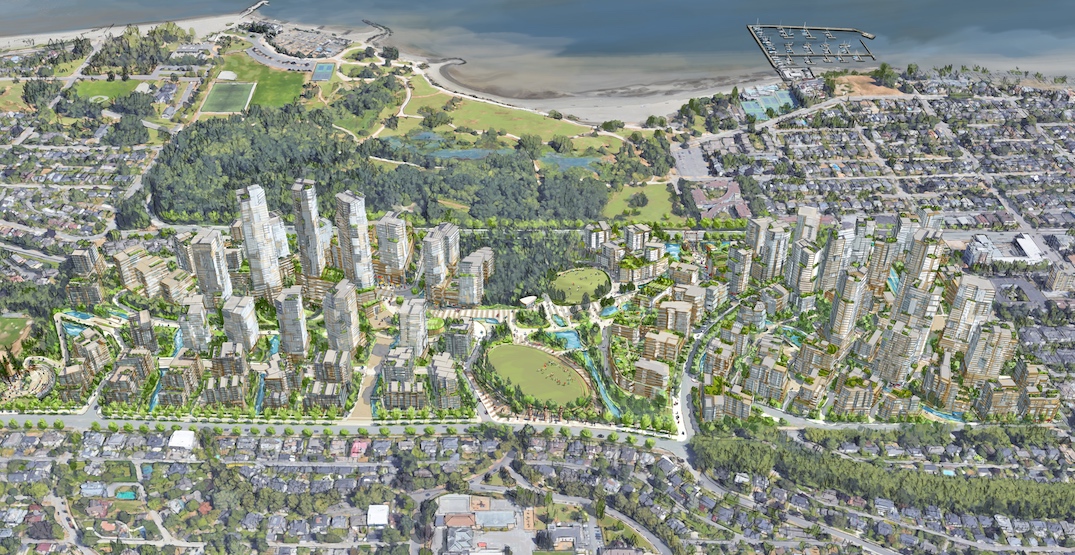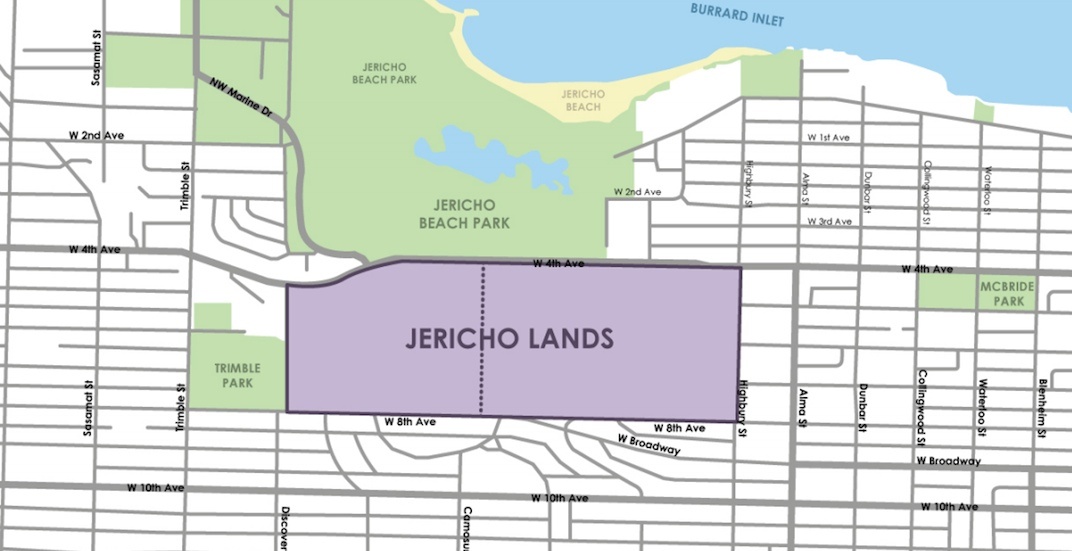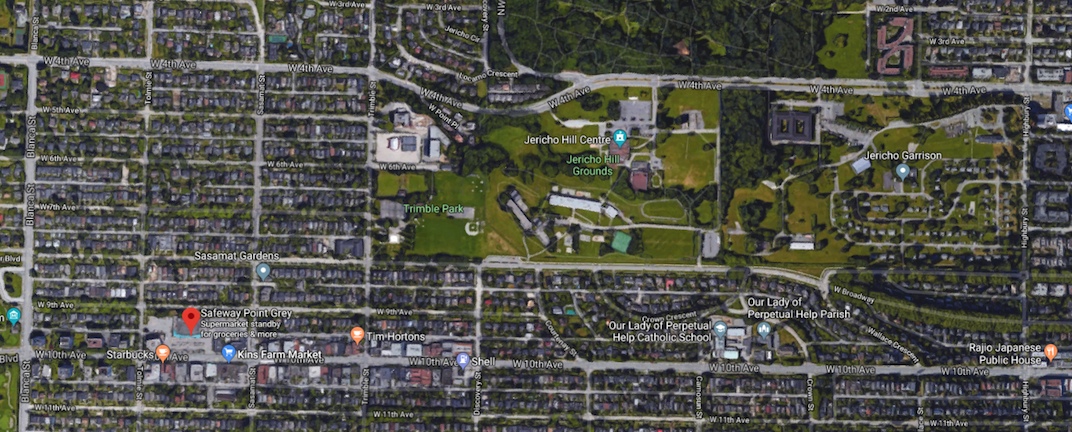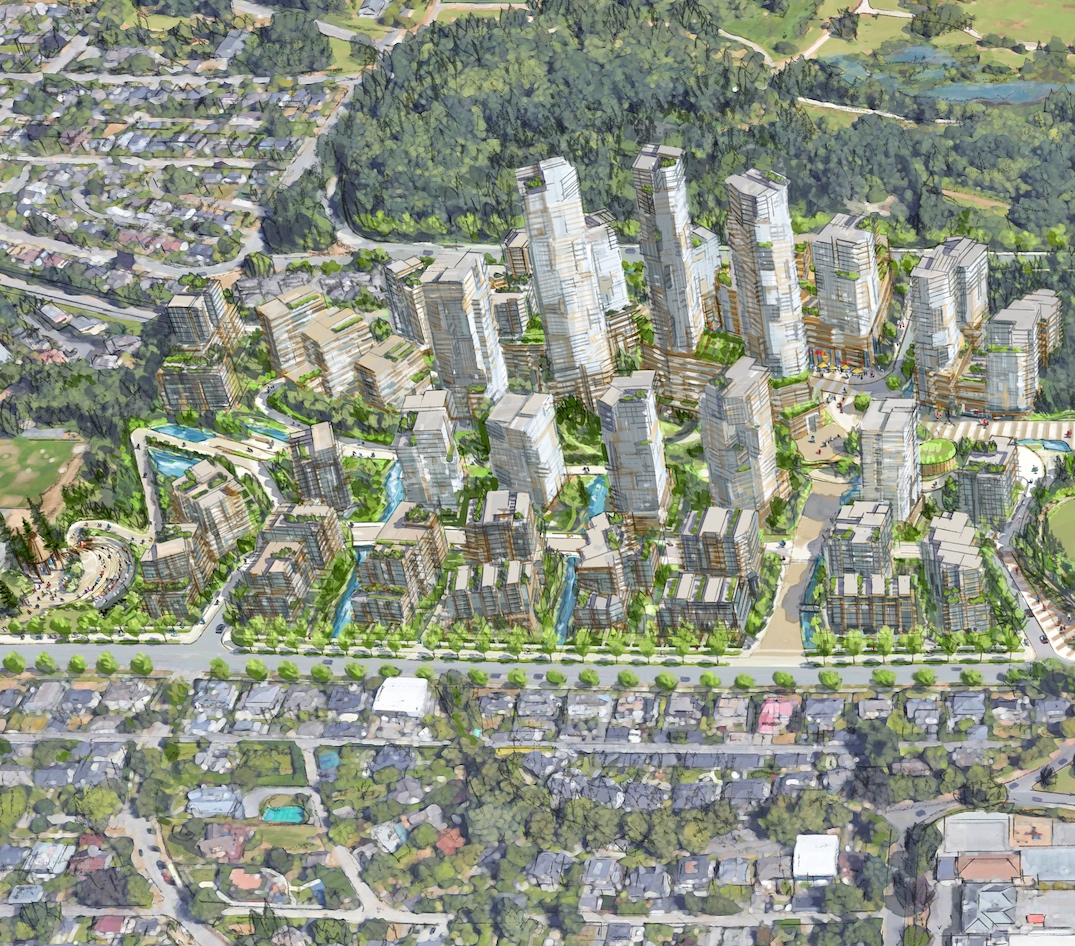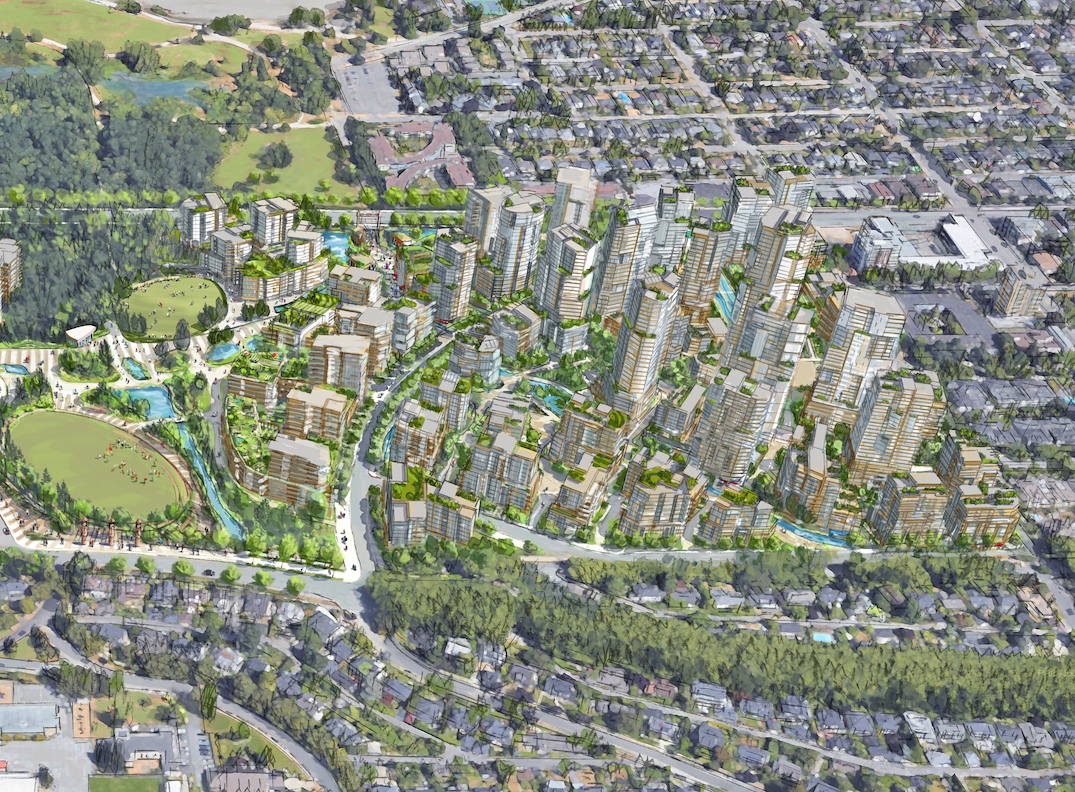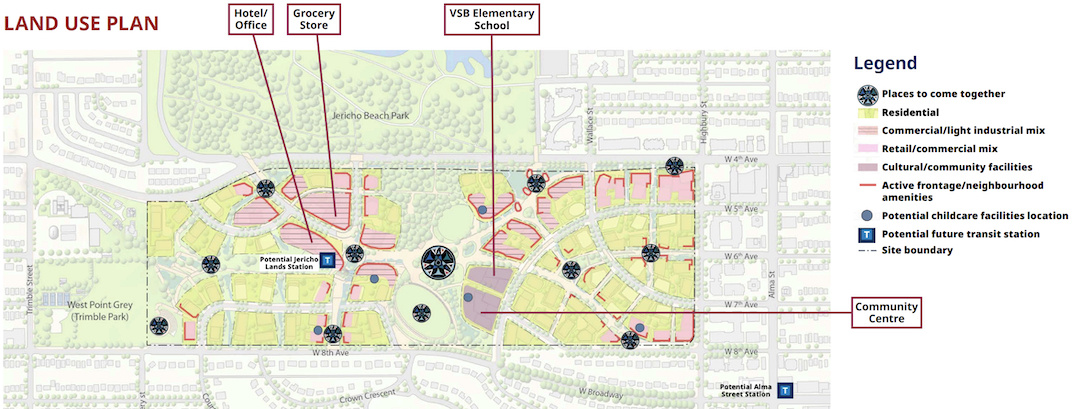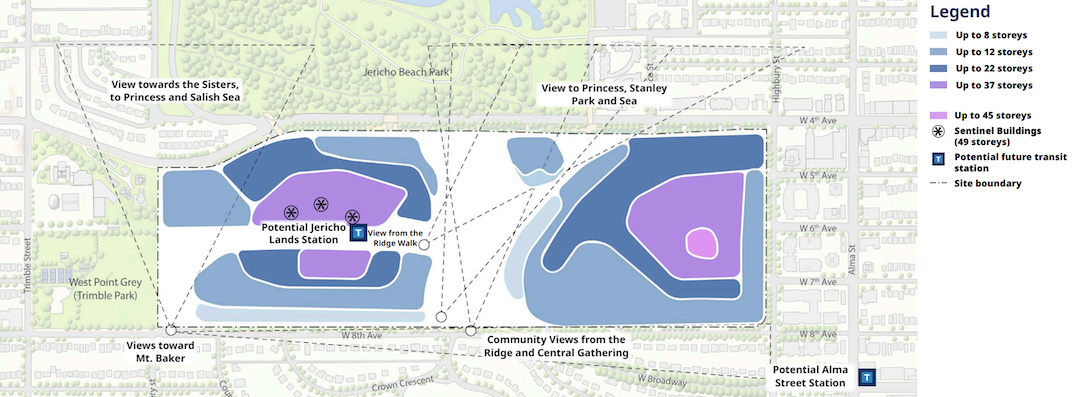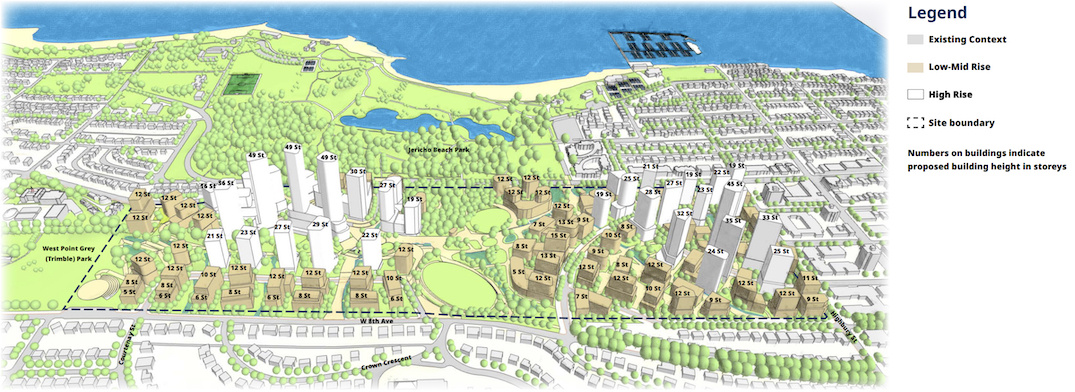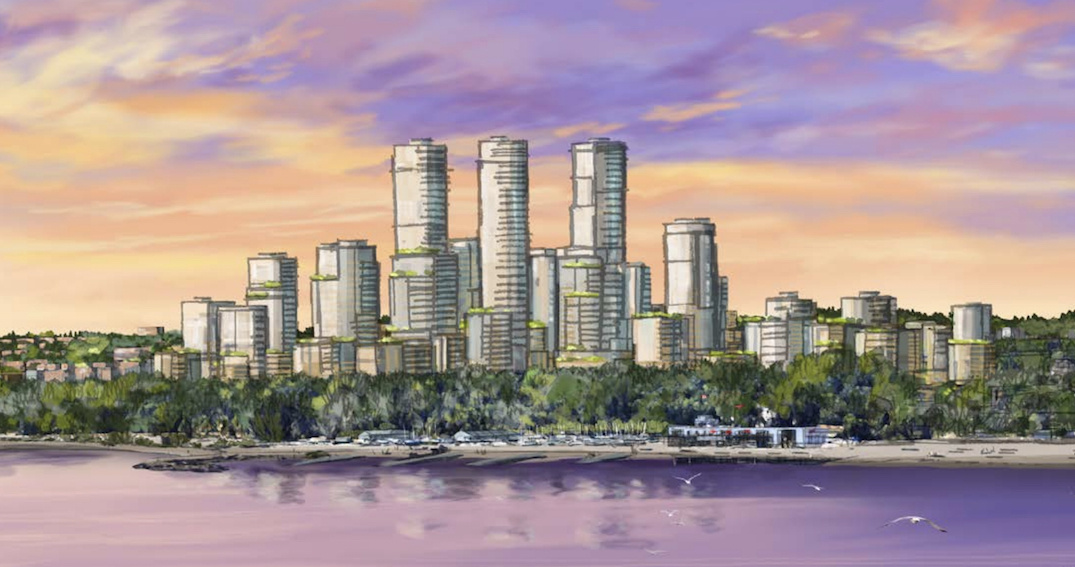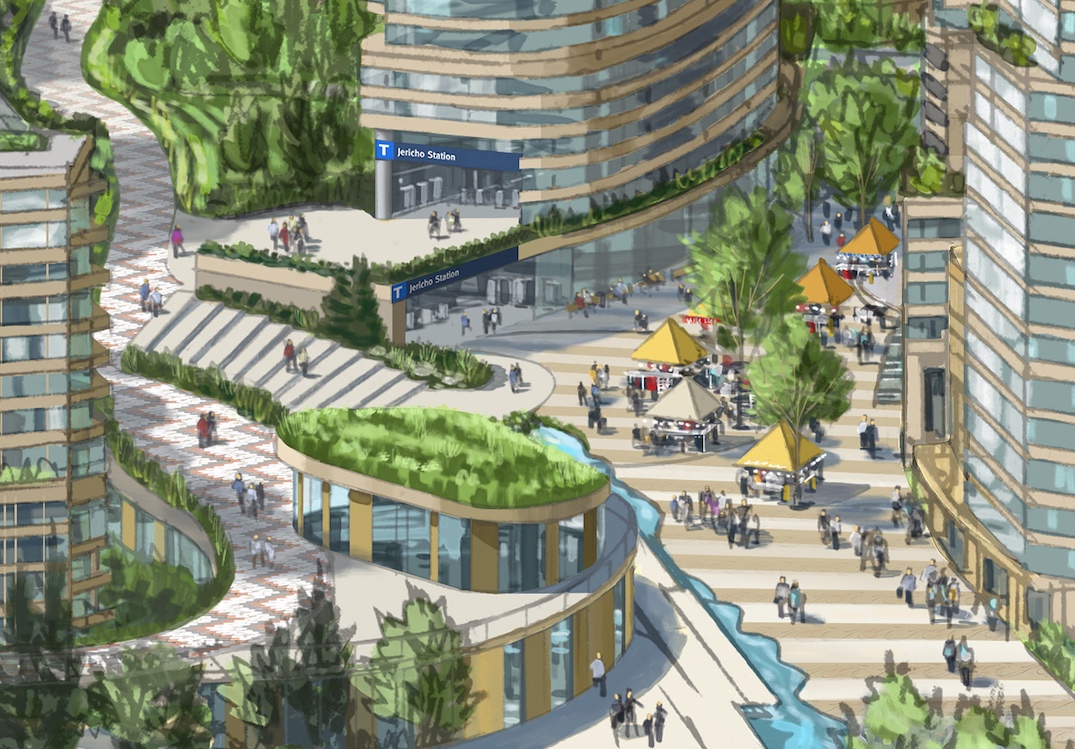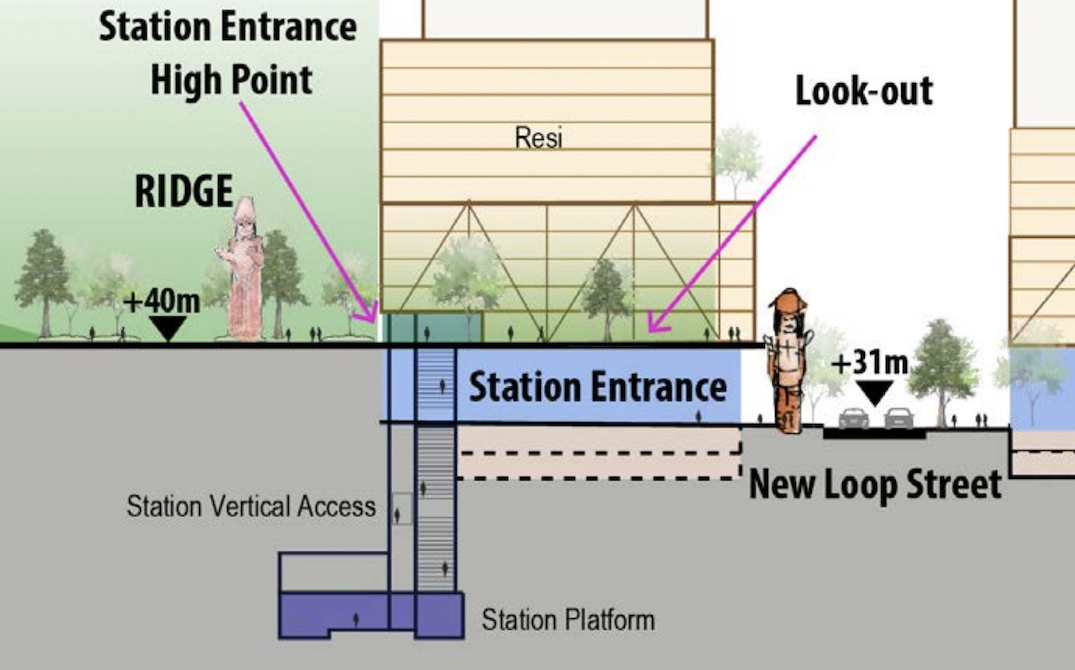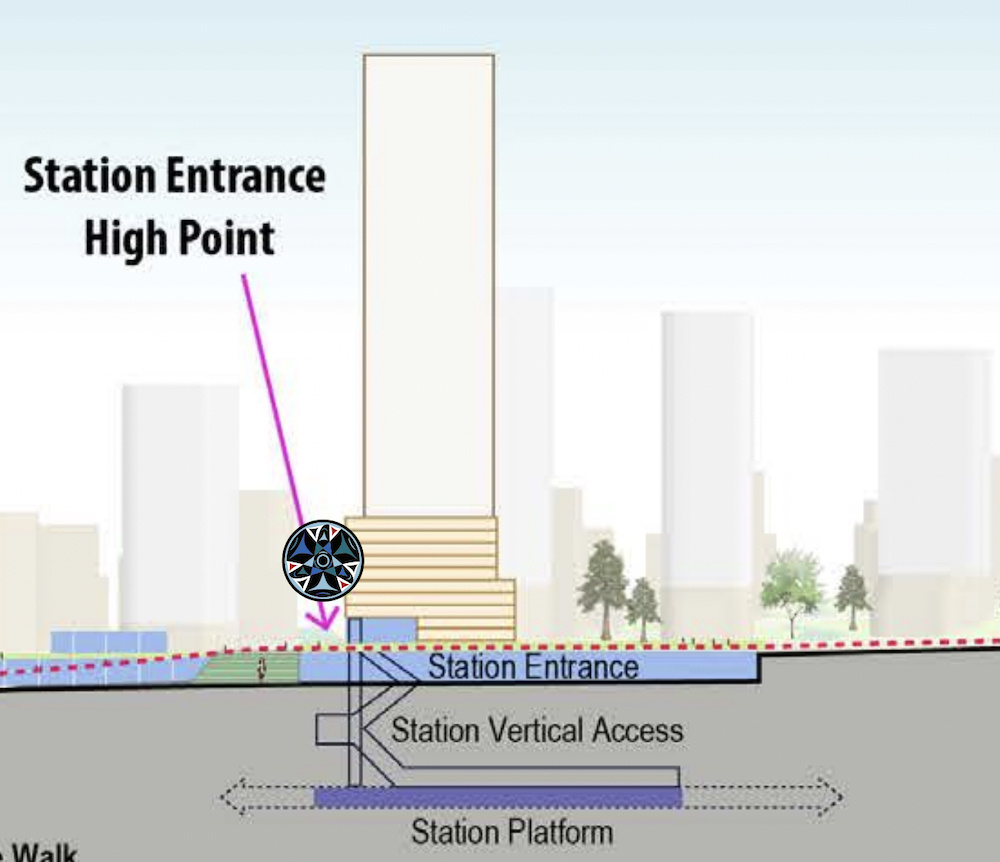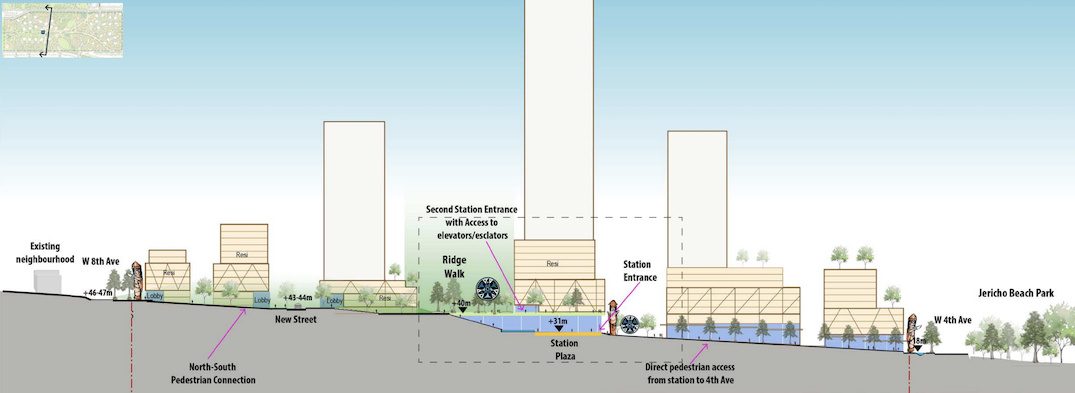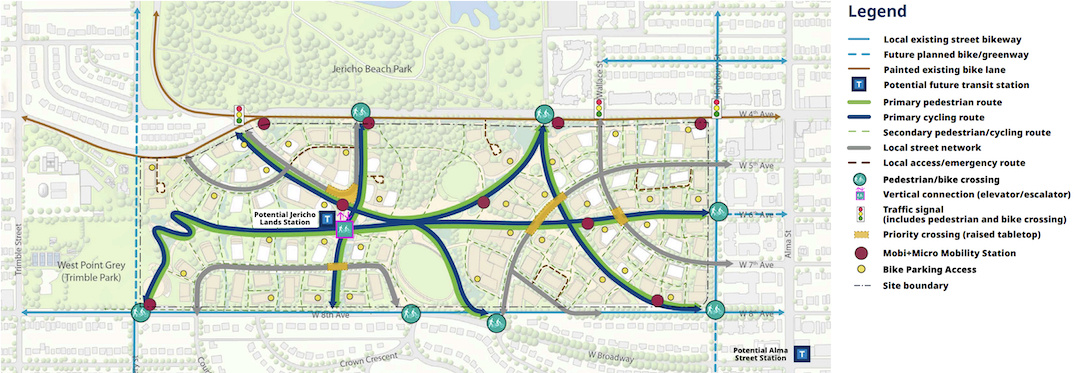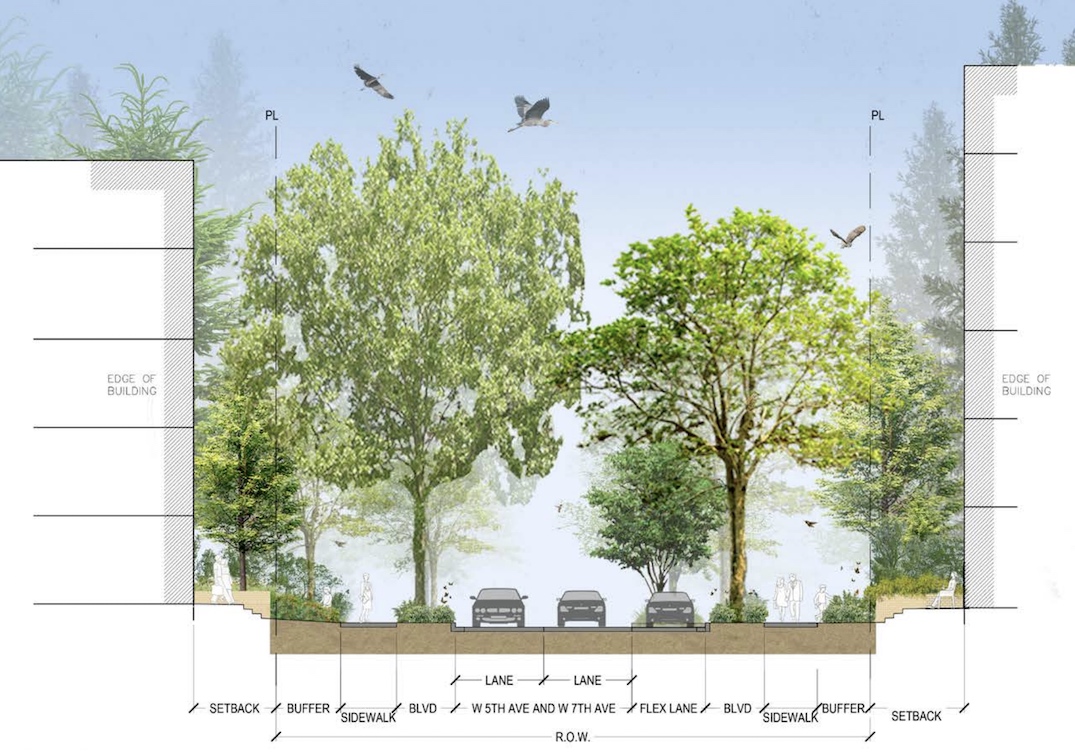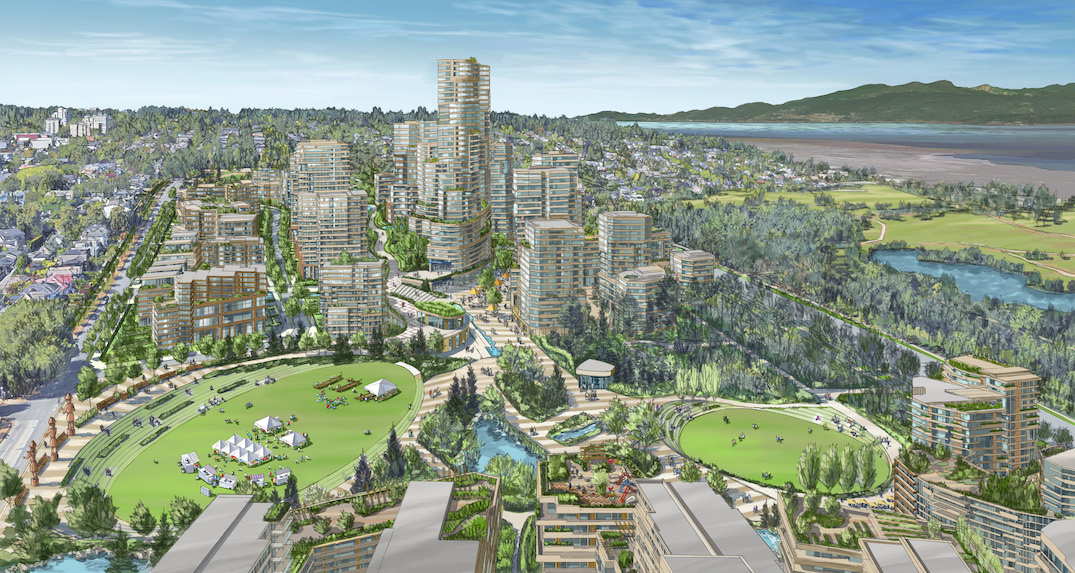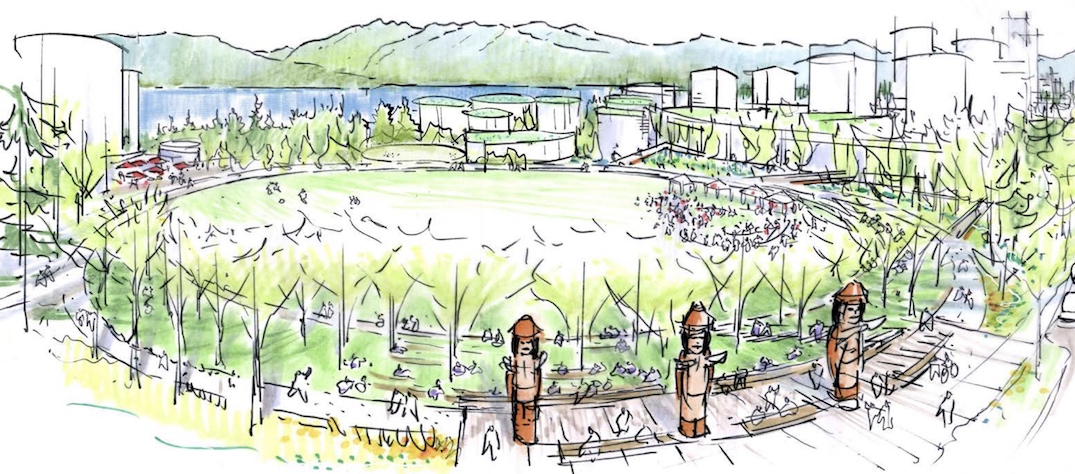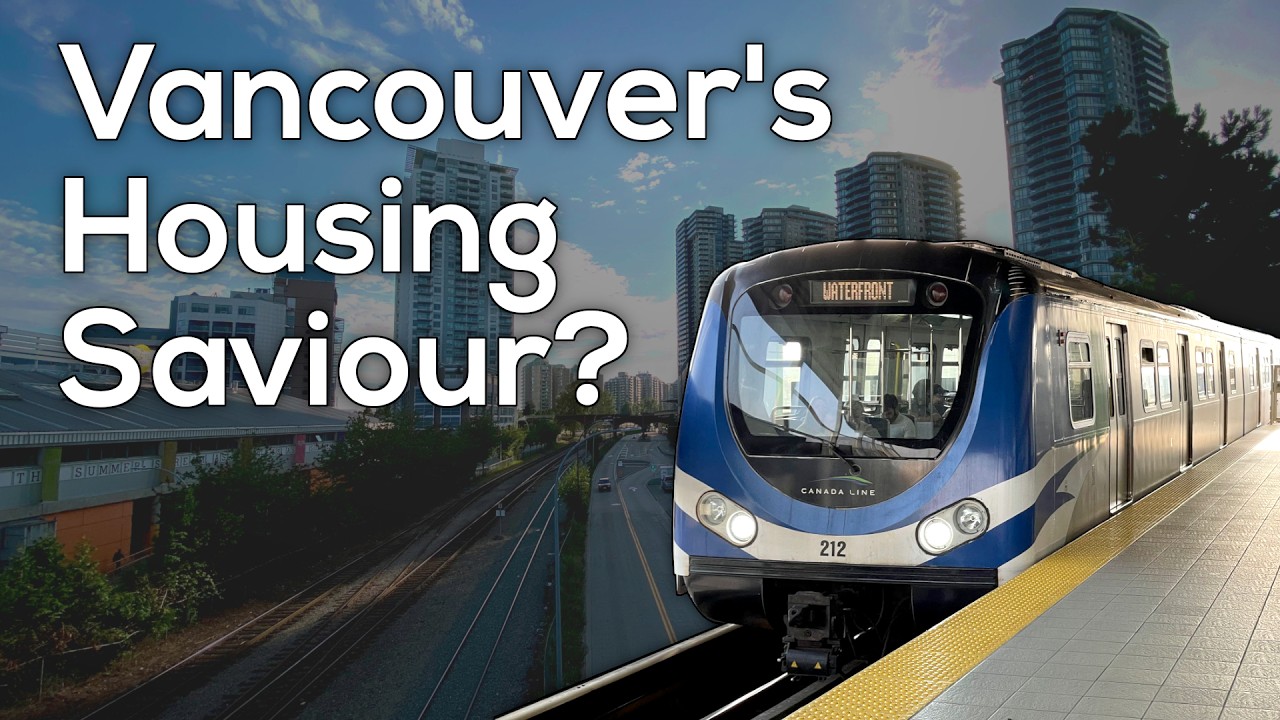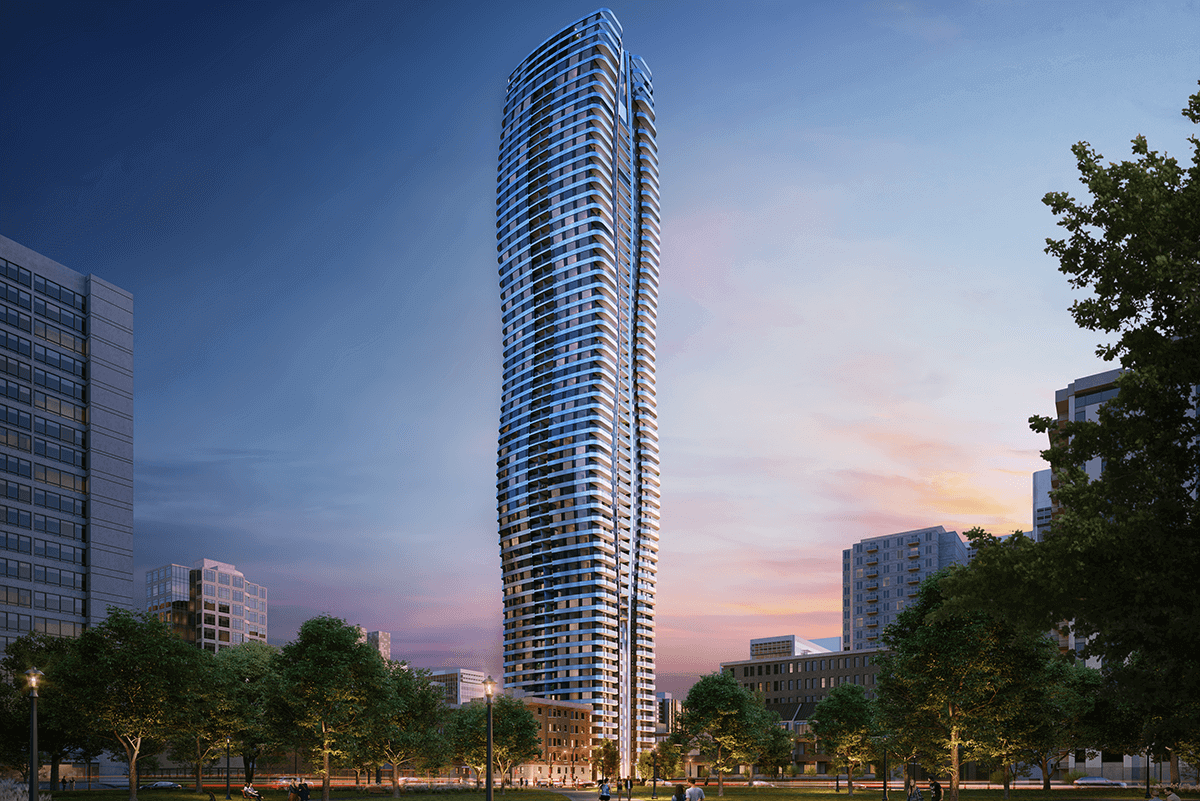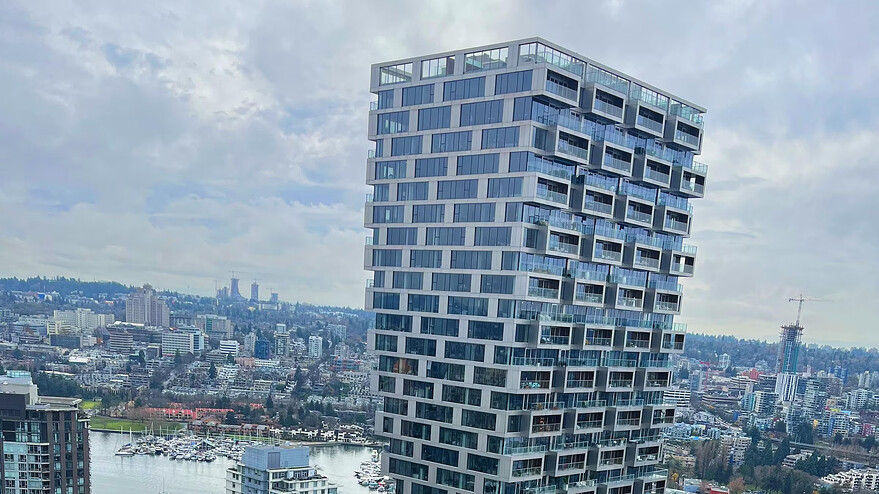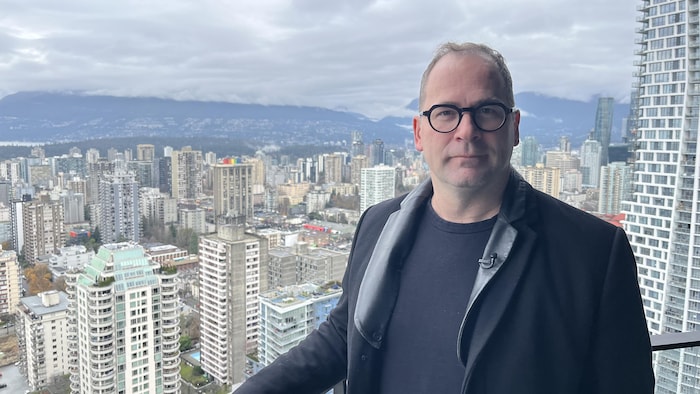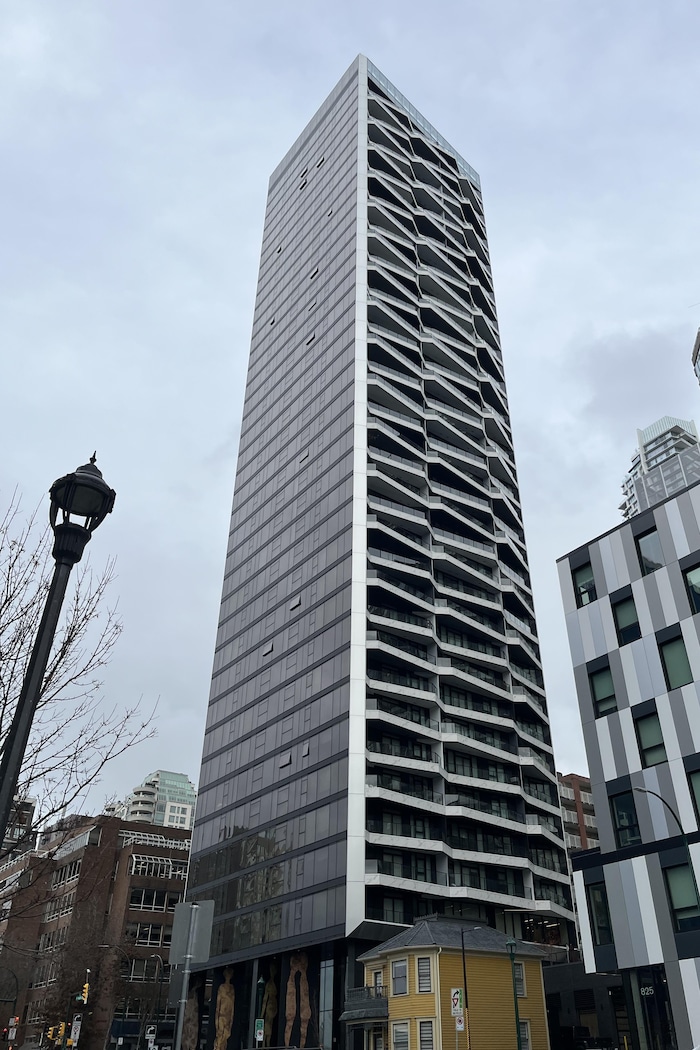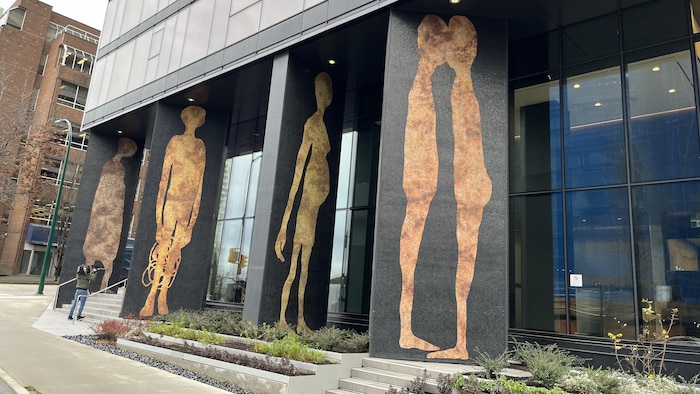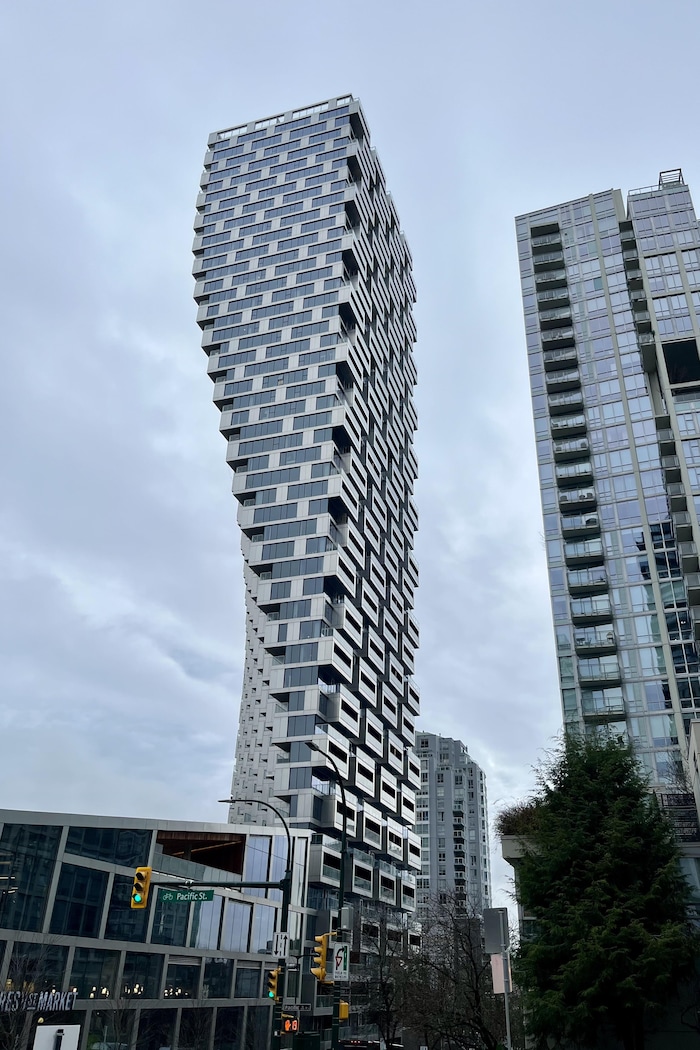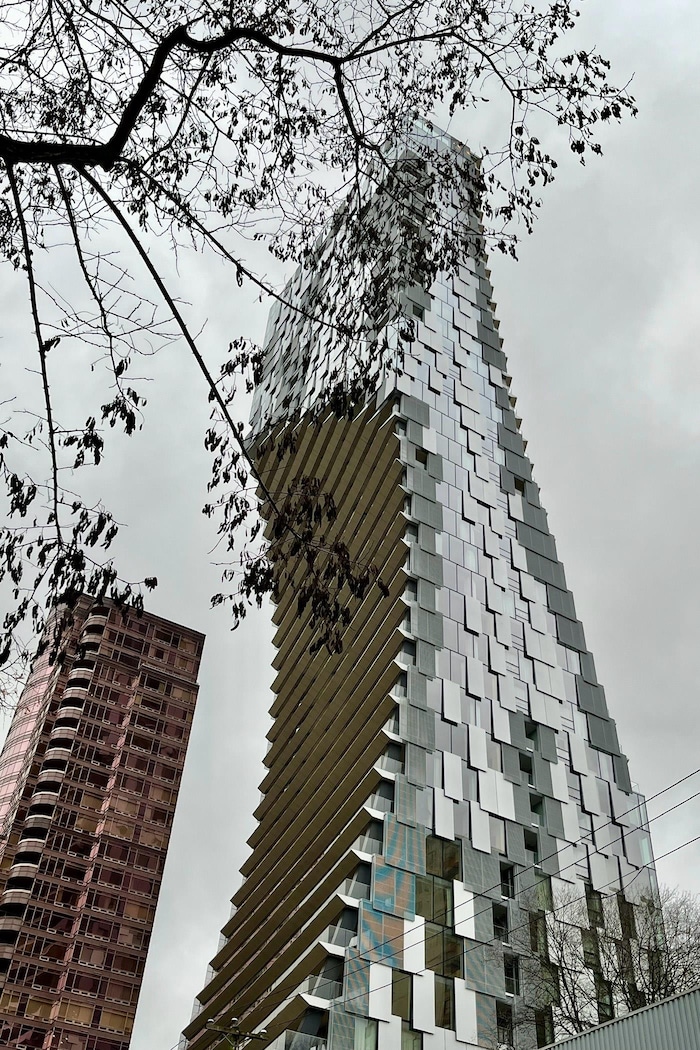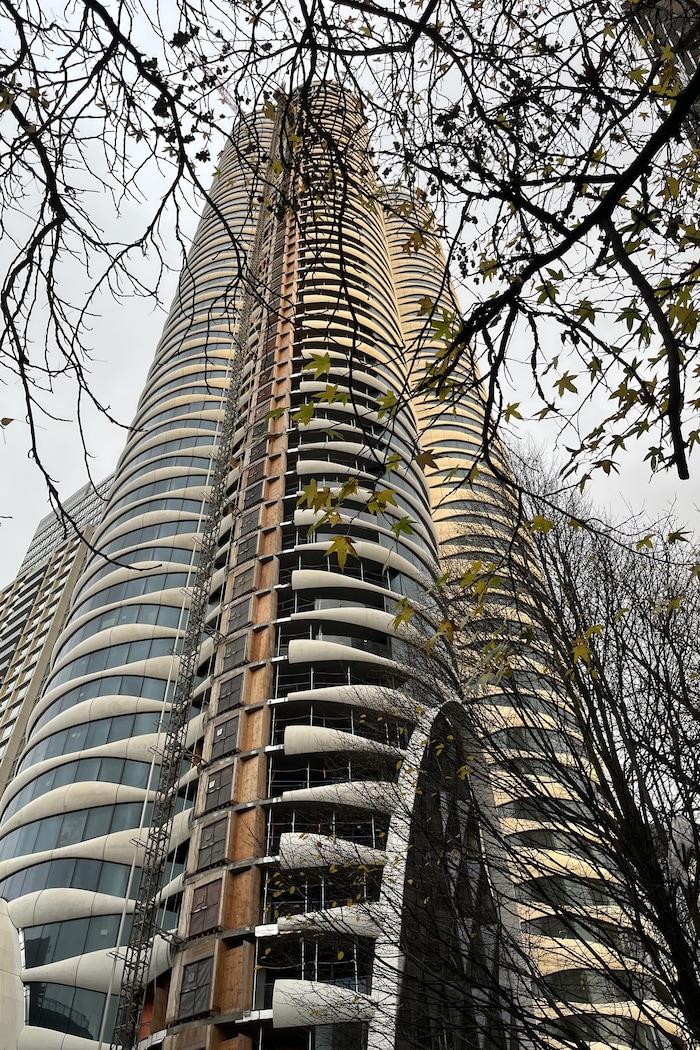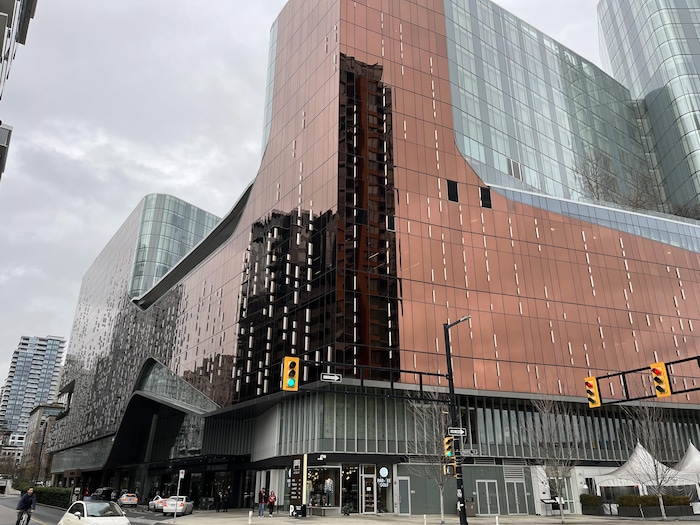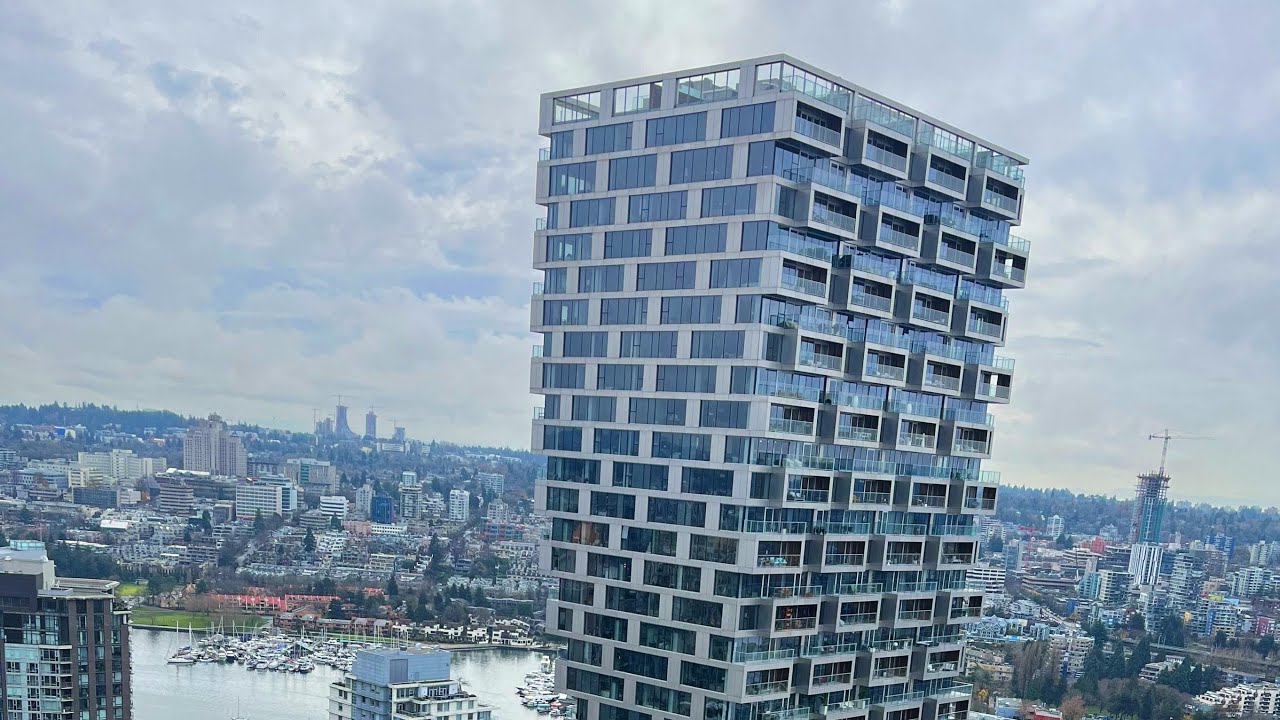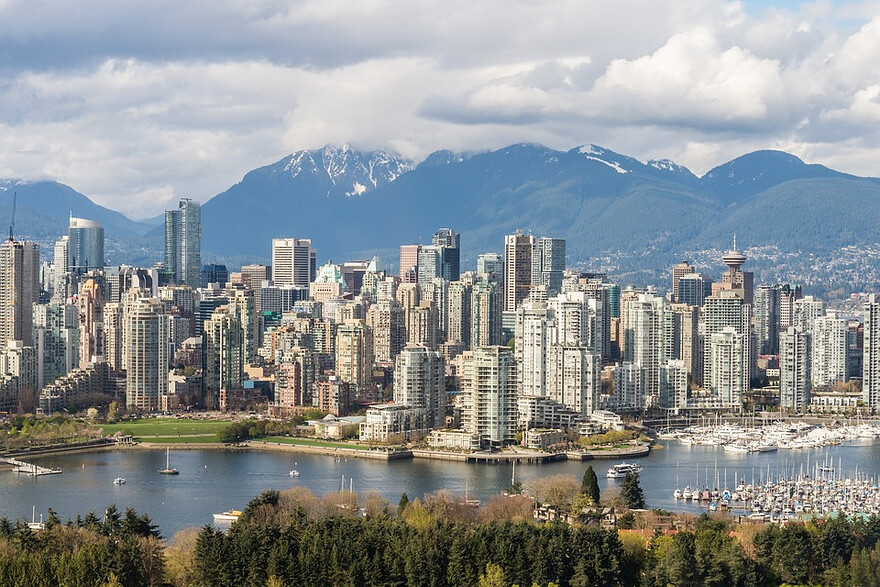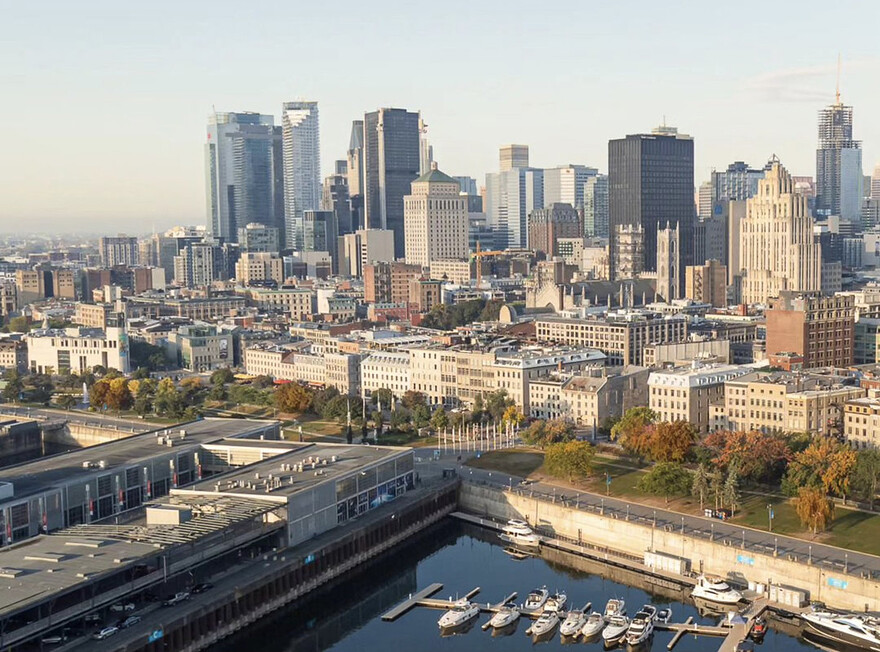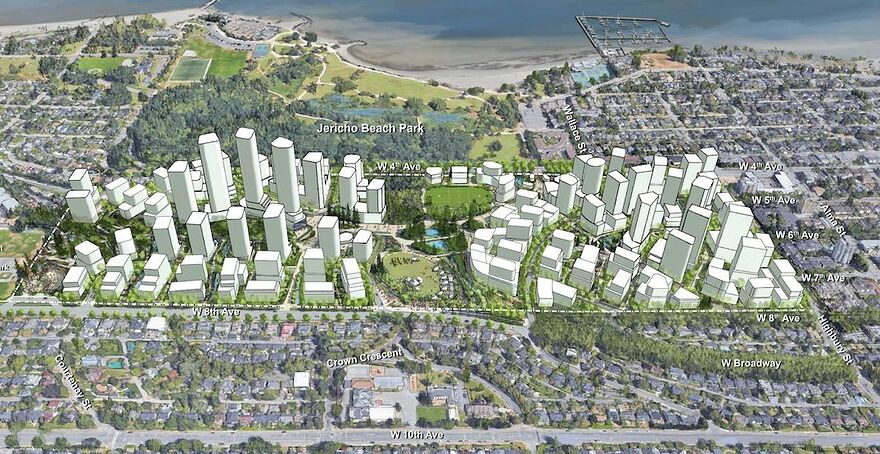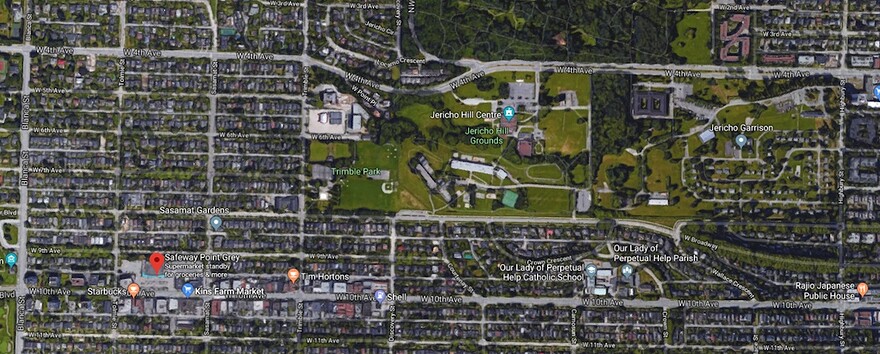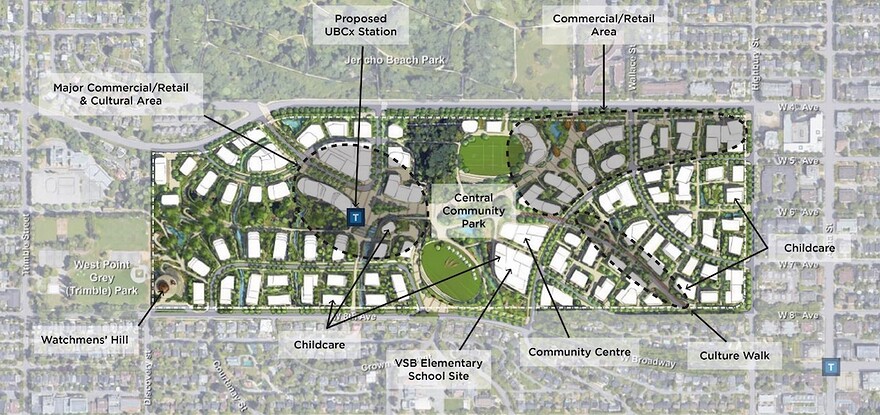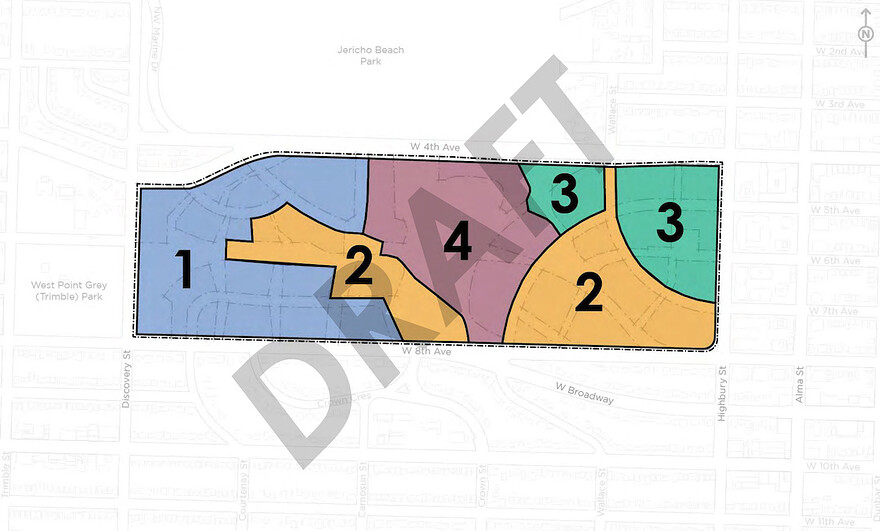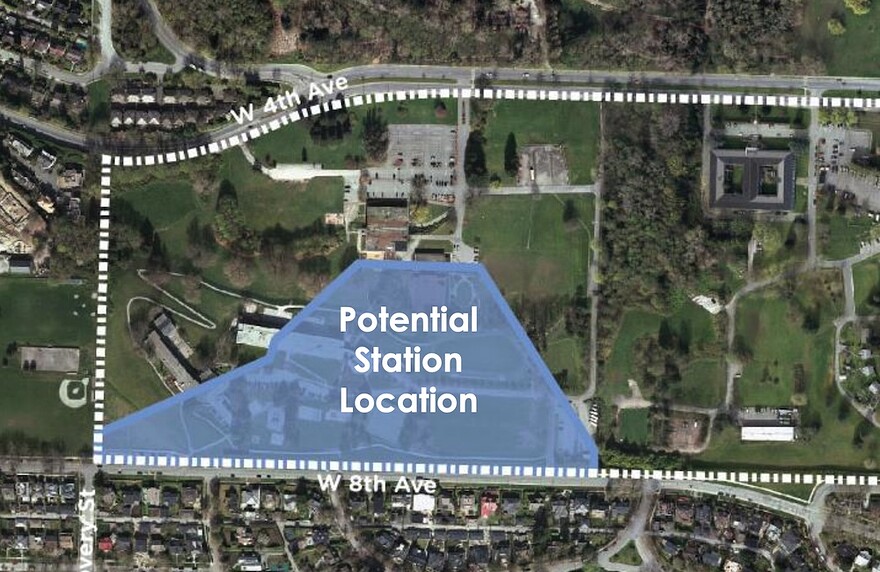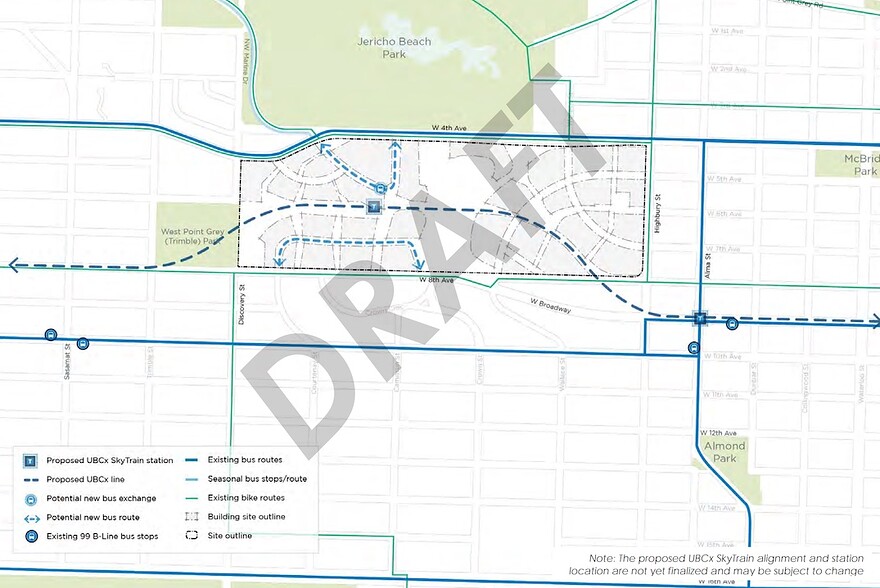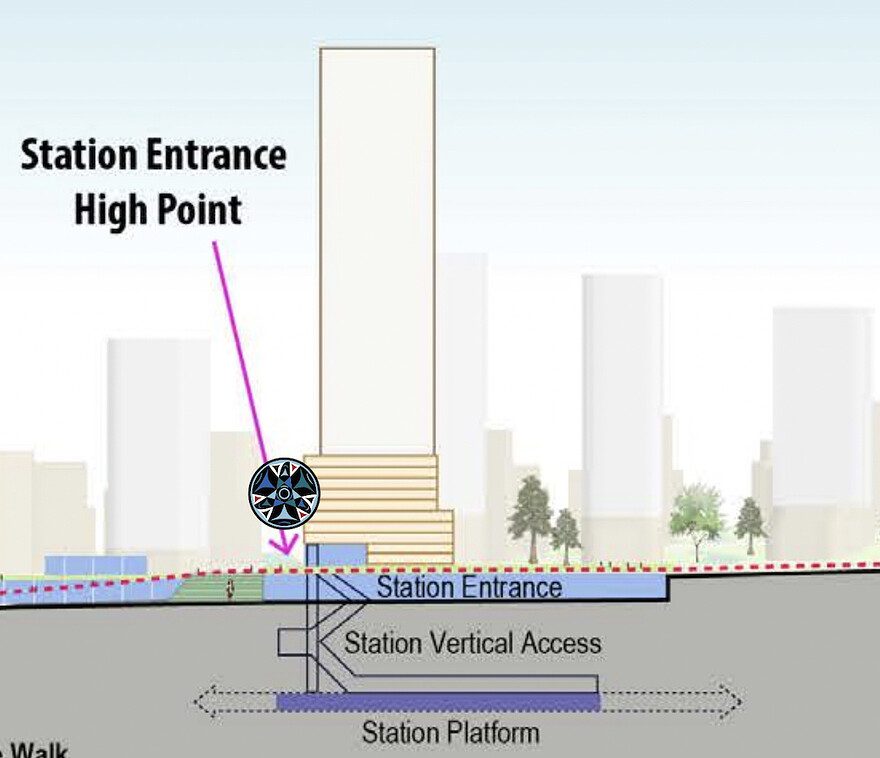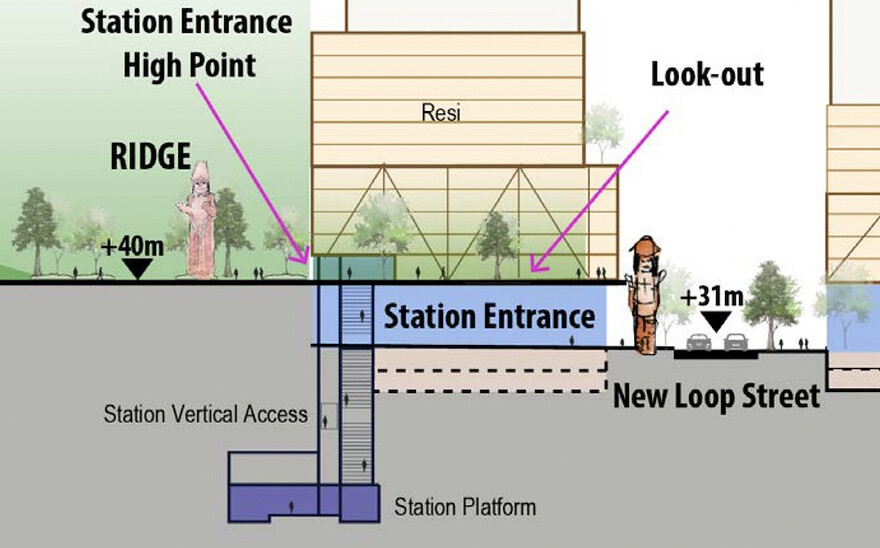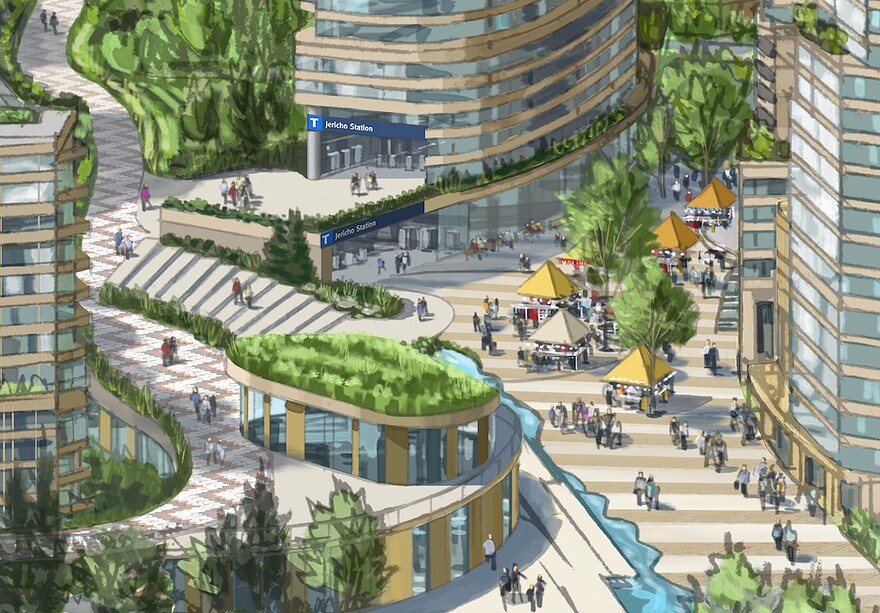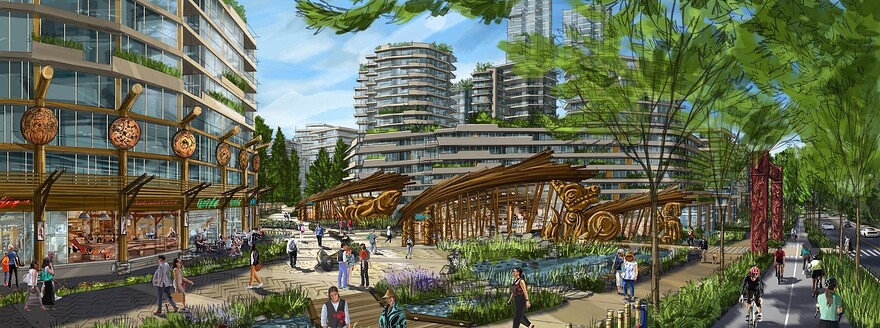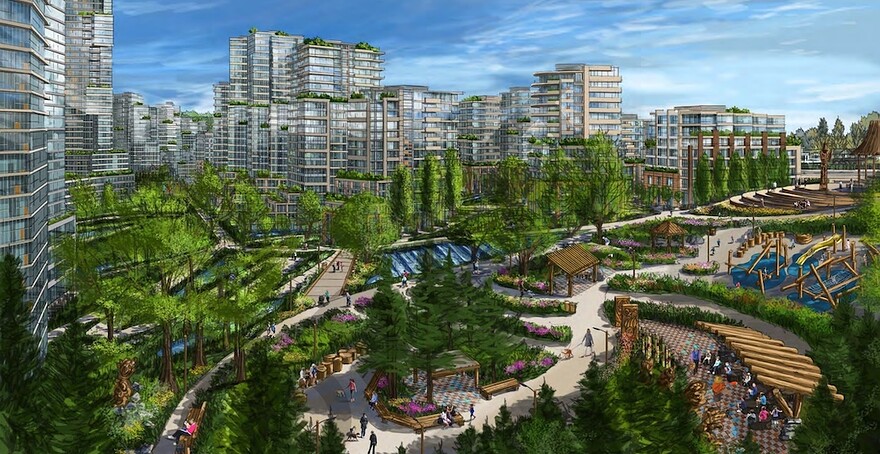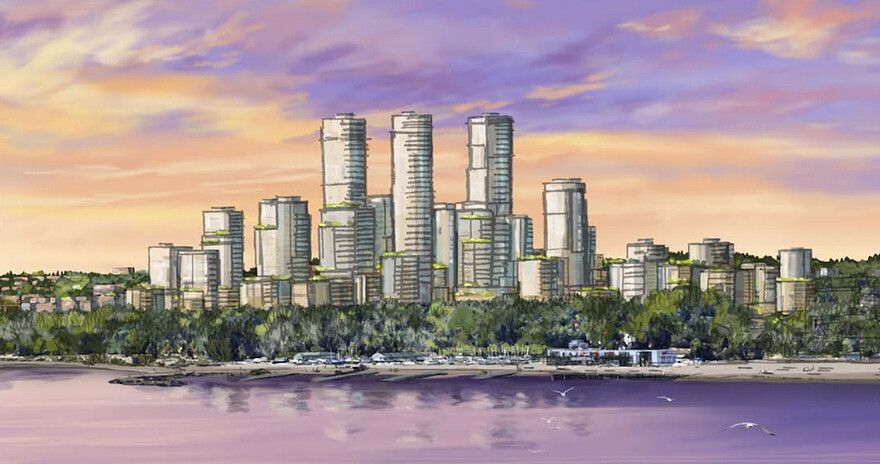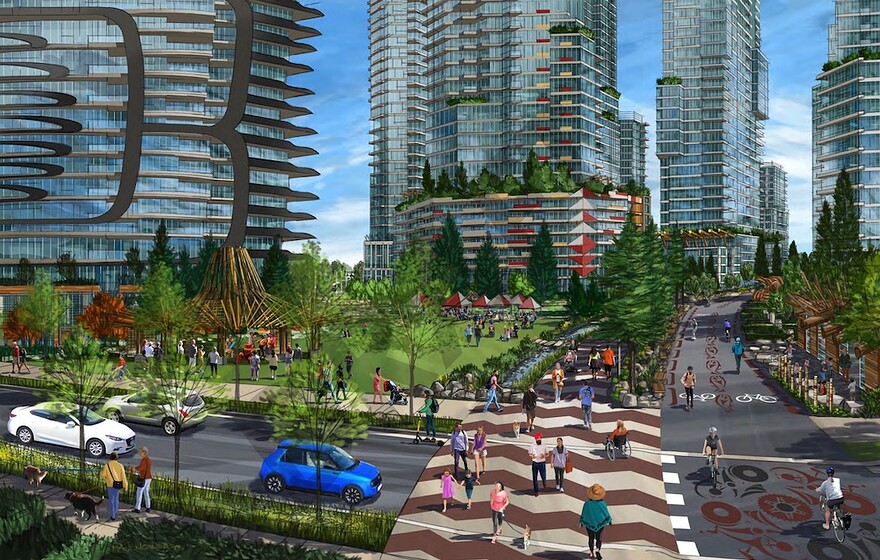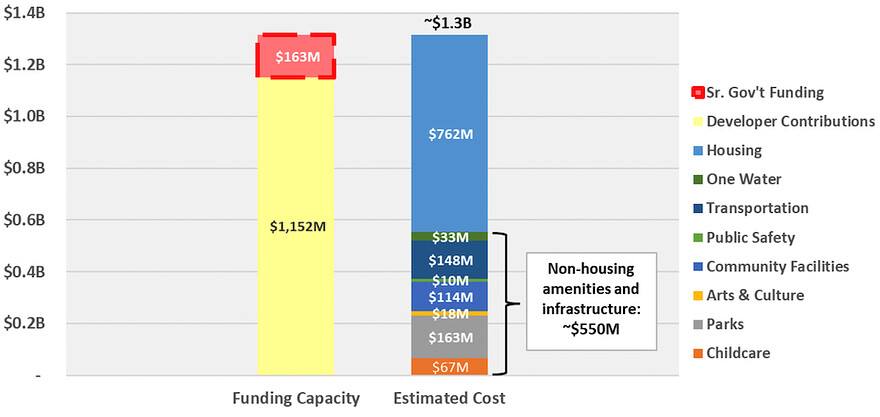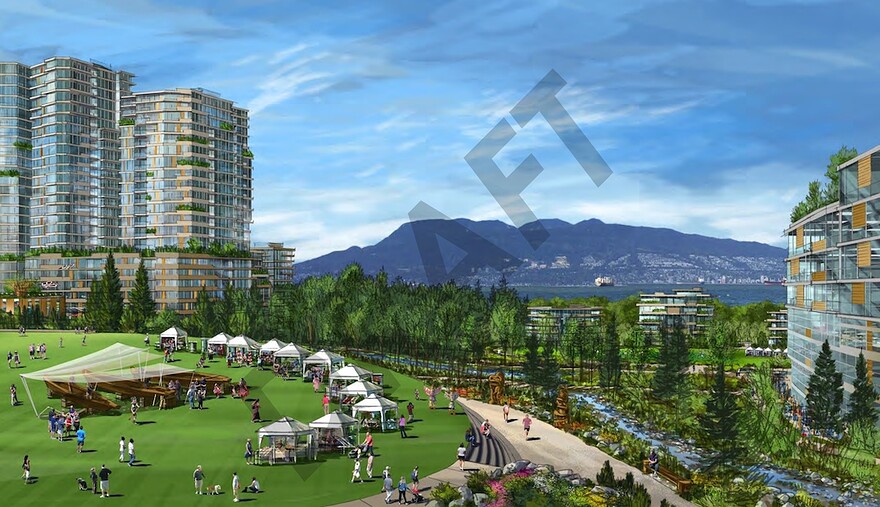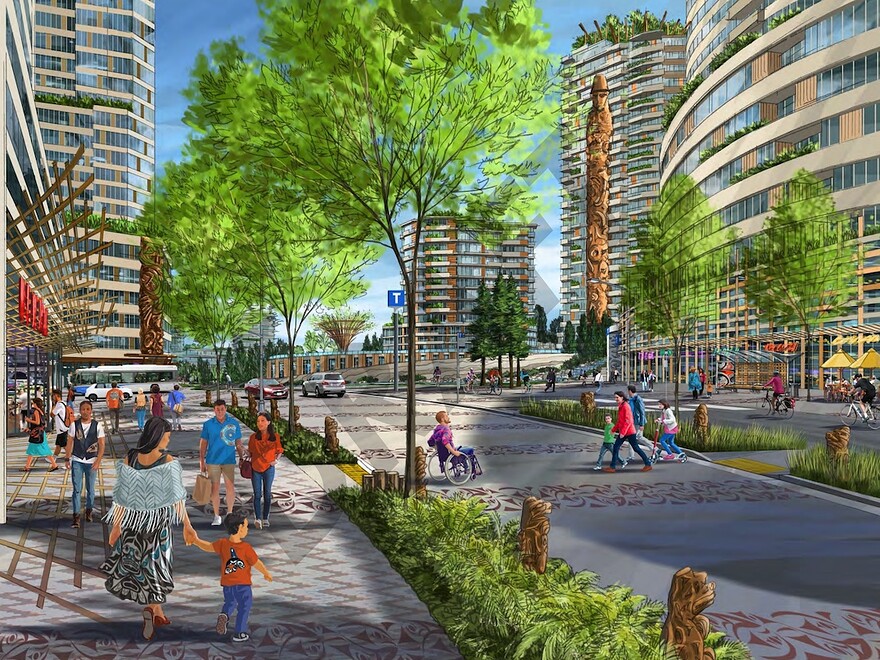Amazing news from Vancouver, this is a densification wet dream
Kenneth Chan | Jun 16 2023, 12:10 pm
Nearly 20 months after potential preliminary concepts for the development of the Jericho Lands in Vancouver’s West Point Grey neighbourhood were first unveiled, a newly revised concept now calls for even more housing and job space achieved through taller buildings for more density.
As of June 2023, the Indigenous-led project now envisions 13,000 homes for up to 24,000 residents — up from the October 2021 concept of 9,000 homes for 15,000 to 18,000 residents. Correspondingly, the total building floor area for all types of uses will now reach 13.6 million sq ft, an increase from the previous 10 million sq ft. There would also be 3,000 on-site jobs.
Compared to the Squamish First Nation’s solo Senakw project, the new Jericho Lands concept generates more than two times the number of homes, and its total building floor area is nearly triple the size.
If realized as outlined, Jericho Lands would more than double the entire West Point Grey neighbourhood’s existing population of 13,000 residents.
Jericho Lands spans 90 acres — a largely undeveloped site and former military installation framed by West 4th Avenue to the north, Highbury Street to the east, West 8th Avenue to the south, and Trimble Park to the west. Senakw at the south end of the Burrard Bridge is just under 11 acres.
Site of the Jericho Lands in the Vancouver Westside. (City of Vancouver)
Aerial view of West Point Grey Village, Jericho Garrison Lands, and the surrounding single-family residential neighbourhood. (Google Maps)
Unlike Senakw, the Jericho Lands are not on reserve, and the project is being spearheaded by the MST Development Corporation — the development company jointly owned by the Musqueam, Squamish, and Tsleil-Waututh First Nations — and federal Crown corporation Canada Lands Company. The partnership acquired the two parcels that form the Jericho Lands from the provincial and federal governments about a decade ago.
As the project is not on reserve, it is going through the City of Vancouver’s policies and processes. Currently, the proponents are in the midst of drafting a master plan for the site — a policy statement that requires Vancouver City Council’s approval. This master plan will guide future rezoning applications for the many construction phases of Jericho Lands over 20 to 30 years.
Short of pursuing a reserve status for the site, the three First Nations intend to maintain their ownership of the land forever by limiting any homeownership opportunities to leasehold strata, which is a long-term lease arrangement for a home. According to the proponents, as leasehold strata do not provide land ownership, such a housing tenure is expected to make homeownership relatively more affordable compared to the conventional freehold housing tenure of owning both the home and land, with most of the home price usually generated from high land values.
Additionally, as previously proposed, at least 30% of the total residential building floor area will be affordable housing, including 20% social housing and 10% secured rental housing for moderate incomes. The revised concept estimates these housing tenure ratios will equate to about 2,600 social housing units and approximately 1,300 moderate-income rental housing units.
Western parcel; June 2023 revised concept of the Jericho Lands. (MST Development Corporation/Canada Lands Company)
Eastern parcel; June 2023 revised concept of the Jericho Lands. (MST Development Corporation/Canada Lands Company)
Land use map; June 2023 revised concept of the Jericho Lands. Click on the image for an enlarged version. (MST Development Corporation/Canada Lands Company)
The revised concept now calls for about 30 high-rise towers, with the vast majority of these towers carrying a height of over 20 storeys.
The tallest towers on the eastern half of the site are 27, 28, 32, 33, 35, and 45 storeys, while the tallest on the western half are a pair of 27-storey buildings, 29 storeys, 30 storeys, 36 storeys, and a trio of 49 storeys. These three 49-storey towers — named the “Sentinels” — represent each of the three First Nations and would be amongst the tallest buildings in Vancouver outside of the downtown peninsula.
In contrast, the previous concept in 2021 envisioned fewer and shorter high-rise towers, with the three Sentinel landmark towers at 38 storeys each and the site’s second tallest building at 32 storeys. The new, more ambitious concept will create a major new skyline in West Point Grey.
Several other dozen buildings on the site will be low- and mid-rise buildings, ranging from five to 15 storeys. Roughly half of the site’s buildings, generally the shorter structures, will use wood construction as a low-carbon greener design strategy.
Although the project will generate a massive critical mass of new building floor area, its floor area ratio (FAR) density is relatively low when the site is viewed as a whole — a FAR of a floor area that is 3.5 times larger than the entire land area.
General building height ranges (number of storeys); June 2023 revised concept of the Jericho Lands. (MST Development Corporation/Canada Lands Company)
Specific building heights (number of storeys); June 2023 revised concept of the Jericho Lands. Click on the image for an expanded version. (MST Development Corporation/Canada Lands Company)
West parcel skyline showing the Sentinels (east parcel skyline not depicted); June 2023 revised concept of the Jericho Lands. (MST Development Corporation/Canada Lands Company)
“Following the release of two conceptual site plan options in Fall 2021, MST leadership asked the project team to review whether ʔəy҆alməxʷ/Iy҆álmexw/Jericho Lands could provide additional housing and affordability, greater inclusivity and open spaces, additional employment and training opportunities, and a deeper recognition of the cultural importance of the site,” reads the rationale for the more ambitious project.
Building on the previous concept, the area of the Sentinels continues to serve as the primary employment cluster on the Jericho Lands, where substantial commercial uses, including office, hotel, and retail/restaurant, are proposed.
But the newly revised concept now introduces significantly more commercial uses across the entire site, with retail/restaurant uses distributed to more areas. This includes new smaller retail/restaurant clusters along the southern edge and intensification of retail/restaurant uses of the east-west pedestrian promenade stretching from the site’s northeast corner with West 4th Avenue through the Sentinels to the northwest corner.
New preliminary conceptual artistic renderings and drawings suggest a retail strip experience not entirely dissimilar to the Whistler Village Stroll.
As well, the revised concept adds the additional employment use of creative industrial spaces, such as maker spaces, creative manufacturing, digital production, and research.
The total building floor area of the revised concept’s employment uses was not provided, but the project’s updated descriptions and drawings suggest it will be more than the previous figure of one million sq ft.
In Spring 2022, TransLink and the previous makeup of Vancouver City Council endorsed a SkyTrain Millennium Line extension route to the University of British Columbia that takes a slight detour north to directly serve the Jericho Lands, effectively providing the development with the ability to increase its transit-oriented density potential.
The revised proposal for the development offers a more detailed conceptualization of how a Jericho Lands Station could potentially be built into the site, right beneath the Sentinels, where the density and employment uses are greatest. There could be two entrances into the subway station to improve its accessibility on the sloped site, with the entrances stacked on top of each other. The on-site Jericho Lands Station — in lieu of a station at Sasamat Street to directly serve the existing West Point Grey retail strip on West 10th Avenue — would complement Alma Station (at the intersection of Alma Street and West Broadway) just to the east.
TransLink’s recommended route and station locations for UBC SkyTrain, April 2022. (TransLink)
Two subway entrances at different levels for SkyTrain Jericho Station beneath the Sentinels; June 2023 revised concept of the Jericho Lands. (MST Development Corporation/Canada Lands Company)
June 2023 revised concept of the Jericho Lands. (MST l Development Corporation/Canada Lands Company)
SkyTrain Jericho Station concept; June 2023 revised concept of the Jericho Lands. (MST Development Corporation/Canada Lands Company)
SkyTrain Jericho Station concept; June 2023 revised concept of the Jericho Lands. (MST Development Corporation/Canada Lands Company)
June 2023 revised concept of the Jericho Lands. (MST Development Corporation/Canada Lands Company)
June 2023 revised concept of the Jericho Lands. (MST Development Corporation/Canada Lands Company)
Overall, the configuration and layout of the Jericho Lands site is a hybrid of the “Eagle” and “Weave” concepts in 2021.
Some city public streets will be extended into the site, but through-roads and roadways for vehicles will be relatively limited for an emphasis on dedicated pathways for pedestrians and cyclists, such as greenways.
Over 13 km of pedestrian and cyclist pathways across the site would be aligned with the hillside topography. This includes north-south pathways from West Point Grey Village retail strip on West 10th Avenue to West 4th Avenue and Jericho Beach Park. Connectivity to the beachfront will greatly improve. Where there is steep terrain, switchbacks will create a more gentle walking and cycling grade.
The change in elevation on the Jericho Lands site from the top of the ridge at the site’s southwest corner (next to Trimble Park at West 8th Avenue) and to the bottom at the northeast corner (intersection of West 4th Avenue and Highbury Street) is about 60 metres (200 ft).
The stretch of West 4th Avenue bordering the Jericho Lands could undergo a redesign that narrows the roadway by reducing vehicle lanes and eliminating the existing median while also improving north-south accessibility between the new neighbourhood and the beachfront.
Roadway and pathway network; June 2023 revised concept of the Jericho Lands. Click on the image for a larger version. (MST Development Corporation/Canada Lands Company)
June 2023 revised concept of the Jericho Lands. (MST Development Corporation/Canada Lands Company)
The project will set aside 33% of its land area — about 30 acres — for parks and open spaces and recreational and naturalized uses. This entails approximately 20 acres of park space and 10 acres of sports fields, playgrounds, and natural and forested areas. These spaces are made possible by pursuing density vertically with taller buildings, as opposed to horizontal densification with low- and mid-rise structures that use a larger footprint.
This specifically includes a gathering place called “Watchmen’s Hill” next to Trimble Park at the top of the ridge, forming a gateway onto the site from where West 8th Avenue meets Discovery Street. This honours the history of the ridge as a lookout.
As a measure to reintroduce natural elements onto the site, it is noted that buried streams that historically crossed through the site will be uncovered and restored to return the seasonal flow of water from the ridge’s southern high points to the southern lower edge along West 4th Avenue.
Towards the centre of the site fronting West 4th Avenue, about 75% of an existing four-acre forest will be retained and enhanced.
Just south of the forest, a large oval gathering place — an outdoor field with a terraced perimeter for seating areas — will take advantage of the slope to create a “natural amphitheatre” and protect views of Burrard Inlet and the North Shore mountains.
There is now also a clearer picture of the possible community facilities to directly serve the substantial new population.
Immediately east of the oval gathering place, space has been set aside for a new community centre, a new public elementary school operated by the Vancouver School Board (VSB), five childcare facilities with a combined total capacity for about 360 kids, and First Nations cultural facilities and spaces.
June 2023 revised concept of the Jericho Lands. (MST Development Corporation/Canada Lands Company)
June 2023 revised concept of the Jericho Lands. (MST Development Corporation/Canada Lands Company)
It is expected the size of the new community centre will at least replace the Vancouver Park Board’s existing Jericho Hill Centre located within the Jericho Lands.
Currently, the Jericho Lands are home to West Point Grey Academy, an independent school for Kindergarten to Grade 12 for roughly 900 students. In addition to the VSB public elementary school, West Point Grey Academy could potentially remain on-site in a different configuration within new buildings. The project’s proponents have noted discussions have been initiated with the school, and they would “very much welcome an opportunity for a new West Point Grey Academy to be located on the lands in the long-term.”
On-site signage, such as street signs, will also be written in the hənq ҆ ҆əmin҆ əm and Sḵwx̱ wú7mesh languages, featured alongside English naming and signs.
The final design of the buildings, mixed uses, parks, open spaces, and other public amenities will be determined in the latter stages of the City’s policy statement later this year. City Council is expected to review the Jericho Lands’ final draft master plan in Fall 2023.
An online survey on the June 2023 revised concept is now open through July 16, 2023.
Chief Wayne Sparrow of the Musqueam says the Jericho Lands is a unique opportunity for the First Nations to not only take their “rightful place as landowners and economic leaders” but also to showcase their culture “like never before.”
“We are proud of our culture and look forward to sharing our way of life and worldview with all who will live in and visit this incredible future neighbourhood. With ʔəy̓alməxw/Iy̓álmexw and other projects made possible by our Nations working together, we are creating modern Indigenous communities where all will be welcome,” said Wilson Williams, spokesperson and general councillor for the Squamish.
Tsleil-Waututh Chief Jen Thoams added: “In returning our culture to these lands, we honour our ancestors and Elders who taught us our traditions and stories. The efforts we make today, together with our relatives Squamish and Musqueam, are not only for the benefit of current generations but also for the next seven generations—for the cultural and financial sustainability of our people.”
MST Development Corporation has also partnered with Canada Lands Company for the 21-acre Heather Lands project — the redevelopment of the former BC RCMP headquarters west of Queen Elizabeth Park on the Cambie Corridor. The master plan and policy statement for the Heather Lands was approved in May 2018, and the rezoning application was approved in June 2022. This separate project alone will generate 2,600 homes, including rental housing and social housing components.
Canada Lands Company is also behind other major redevelopments, such as introducing similar mixed uses — including a new residential neighbourhood — to the federal government property of Downsview Park in Toronto. But it is best known for being the operator of the CN Tower and Montreal Old Port.
